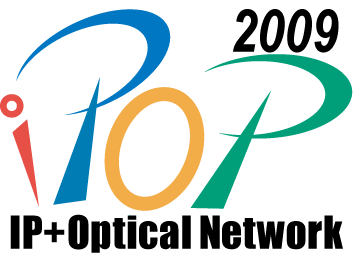Online proceedings
*Notice: PDF files are protected by password, please input "ipop2009.5th". Thank you.
Thursday 11, June 2009
| Opening |
Thursday 11, June 2009 09:10-11:40
Chair: Naoaki Yamanaka, Keio University, Japan
Opening address
- Tomonori Aoyama, General Co-chair, Keio University, Japan
- Bijan Jabbari, General Co-chair, ISOCORE, USA
Keynote
K-1 "Toward the New Generation Network"
- Hiroshi Miyabe, NICT, Japan
 In this talk, framework and R&D toward new-generation network (NWGN),
which solves social problems, supports realization of human or society
potentials, and improves quality of life and the productivity, are
presented. NWGN framework in Japan, NWGN framework and R&D in NICT,
standardization activities for NWGN will be covered.
In this talk, framework and R&D toward new-generation network (NWGN),
which solves social problems, supports realization of human or society
potentials, and improves quality of life and the productivity, are
presented. NWGN framework in Japan, NWGN framework and R&D in NICT,
standardization activities for NWGN will be covered.

Biography:
Dr. Hiroshi Miyabe has been a Vice President, Member of the Board of
National Institute of Information and Communications Technology (NICT)
since April 2008, where he has been in charge of commission research
program and new-generation network R&D of NICT. For his 28-year career
in Nippon Telegraph and Telephone (NTT), he was engaged in R&D and
standardization of Operating System (OS), real-time OS, software
architecture, network security and network architecture. He is a
Fellow of the Information Processing Society (IPSJ) of Japan.
K-2 "MPLS-TP: A common technology for the convergence of IP and transport networks"
- Matthew Bocci, Alcatel-Lucent, UK
 The development of the MPLS Transport Profile is building substantial
momentum in the IETF and ITU-T. Requirements for MPLS in packet
transport networks point to the use of only a subset of MPLS's broad
range of functionality, while enhancing other functions, such as OAM.
This talk will look at the requirements and background to these
developments. We will describe, not only at how MPLS is being enhanced
to meet those requirements for deployment in packet transport networks,
but also at how these new developments can be employed in today's
IP/MPLS networks, thus enabling a common, interoperable technology to be
used across a carrier's service and transport networks.
The development of the MPLS Transport Profile is building substantial
momentum in the IETF and ITU-T. Requirements for MPLS in packet
transport networks point to the use of only a subset of MPLS's broad
range of functionality, while enhancing other functions, such as OAM.
This talk will look at the requirements and background to these
developments. We will describe, not only at how MPLS is being enhanced
to meet those requirements for deployment in packet transport networks,
but also at how these new developments can be employed in today's
IP/MPLS networks, thus enabling a common, interoperable technology to be
used across a carrier's service and transport networks.

Biography:
Matthew Bocci is Director of Technology and Standards with
Alcatel-Lucent's IP Division. He is a regular contributor to the IETF,
where he co-chairs the PWE3 and ANCP working groups, and IP/MPLS Forum
where he is a member of the board of directors. He is co-author of a
number of publications and IETF drafts and RFCs on MPLS-based converged
networks. Previously, Matthew provided advanced technical consulting in
traffic management, signaling and network performance. He holds a PhD in
ATM network modeling from Queen Mary & Westfield College, London, and a
B.Eng(hons)(1st class) degree in Electrical and Electronic Engineering
from University College London. He is a member of Alcatel-Lucent
Technical Academy and the Institution of Engineering and Technology.
Program introduction
- Soichiro Araki, NEC, Japan
Exhibition introduction
- Kohei Shiomoto, NTT and Hideaki Tanaka, KDDI R&D, Japan
|
| Technical Session |
|
Tech. Session 1: New services and Network convergence
Thursday 11, June 2009 13:10-14:50
Chair: Young Lee, Huawei, USA
1-1 "OIF challenges: towards enabling broadband on-demand services"
[Invited] OIF representative (Speaker:Jim Jones, Vice President, OIF)

- Examining drivers for on demand data and video services
- Highlighting the challenges of enabling end-to-end on-demand services in current transport infrastructures
- How can operators evolve to an infrastructure capable of cost effective on-demand service enablement?
- Sharing insights into the work conducted by the OIF (Optical Internetworking Forum) to enable end to end, dynamically provisioned carrier-grade broadband services
- Introducing the OIF control plane IA's and reviewing the results of its 2009 Worldwide Interoperability Demo
- Sharing insights into real deployments and field trials of OIF IA's by global carriers

Biography:
Jim Jones has been a senior systems engineer with Alcatel-Lucent since 1999. He develops architectures and requirements for next-generation networks in the Network and Solutions Architecture group of Alcatel-Lucent's Optical Networks division. He chaired both the Technical Committee and the Architecture/Signaling Working Group of the Optical Internetworking Forum (OIF). He is currently OIF Vice President for Marketing. Before joining Alcatel-Lucent, he developed advanced signal processing systems with Texas Instruments and Raytheon from 1978 to 1999. He received his B.S.E.E. and M.S.E.E. from the University of Michigan, and his M.S. in telecommunications from Southern Methodist University.
1-2 "An Overlay Approach to On-Demand Optical Grid Network Construction for Global Grid Computing over Multi-Domain Wavelength Switched Optical Networks"
Sugang XU, Weiping REN and Hiroaki HARAI, NICT, Japan
 It is believed that future geographically distributed and data-intensive grid applications will take advantage of end-end
lightpaths optical grid network (OGN) built over wavelength switched optical networks (WSON) [1]. To create the
easy-to-use OGN, the construction of OGN as an integrated service for grid applications includes two sub-problems: (1)
on-demand optical L1VPN (MP2MP) automatic construction over multi-domain WSON, (2) OGN users’ end-host
automatic configurations. With the increased complexity, the control issues in L1VPN construction related to the
multi-domain environment are out of the current scope of standardization bodies. To achieve an efficient OGN
construction, the concept of an integrated control plane for both grid and optical network was introduced in the
PHOSPHOROUS project [2]. However, in a multi-domain WSON, between different carriers, with different policies
on network resource information and control message exchanging, it is hard to achieve such a tightly coupled control for
the efficient resource utilization.
It is believed that future geographically distributed and data-intensive grid applications will take advantage of end-end
lightpaths optical grid network (OGN) built over wavelength switched optical networks (WSON) [1]. To create the
easy-to-use OGN, the construction of OGN as an integrated service for grid applications includes two sub-problems: (1)
on-demand optical L1VPN (MP2MP) automatic construction over multi-domain WSON, (2) OGN users’ end-host
automatic configurations. With the increased complexity, the control issues in L1VPN construction related to the
multi-domain environment are out of the current scope of standardization bodies. To achieve an efficient OGN
construction, the concept of an integrated control plane for both grid and optical network was introduced in the
PHOSPHOROUS project [2]. However, in a multi-domain WSON, between different carriers, with different policies
on network resource information and control message exchanging, it is hard to achieve such a tightly coupled control for
the efficient resource utilization.
In this abstract we introduce an optical grid network infrastructure (OGNI) middleware which aids grid applications in
automatic OGN construction. To achieve an easy-to-construct OGN over multi-domain WSON we practice an overlay
approach to the on-demand OGN construction over multi-domain WSON, which implement the OGN construction
function via an end-to-end reachable OGN control plane (e.g. using L2/L3 VPN or the Internet, etc.), and individual
lightpath provisioning via WSON carriers’ control planes, respectively. This overlay approach conceals the
communication architecture of the underlying heterogeneous optical network systems and provides the flexibility to
people to establish composite networking services like optical L1VPN over a complex multi-domain environment. The
end-to-end reachable OGN control plane provides communication channels among users’ ends and enables the overlay
approach. It should be noted that this is the CE-to-CE control plane connectivity before L1VPN construction. The
OGNI running on this OGN control plane with the overlay OGN construction aids people in the integration of globally
distributed computer and network resources, and composes high-level integrated services to grid users.
The OGN for each grid application is constructed and managed in a totally distributed manner by OGN edge node
which is located in each end-host equipped with optical network interfaces. Fig.1 shows a schematic diagram of the
OGN edge node architecture in our OGNI design. Each OGN edge node consists of two sub-systems: grid edge and
optical network edge. The grid edge consists of four components: grid enabler, topology design server, info collector
and autoIFc. Optical network edge employs GMPLS protocols.
OGN applications interact with the grid edge of the local node sending/receiving OGN requests/results through the
application/grid edge interface (AGI). For requests without OGN topology specifications, grid enabler in the grid edge
interacts with topology design server for OGN topology design based on the users’ requirement of optimization and
information (e.g. Traffic estimation, CPU, Memory and end-end lightpath cost, such as price or estimated end-end delay)
collected by info collector. With OGN topology received from topology design server or specified by the application,
grid enabler sends lightpath setup requests directly to the peer grid edges which are the ingress nodes of lightpaths with
lightpath provisioning control token (LPCT) signaling. Peer grid edge then interacts with the local optical network
edge through the grid edge/optical network edge interface (GNI) to setup lightpaths. By collecting the results of
lightpath establishment, and if some lightpaths are blocked, the original grid edge can adjust the OGN topology. Or, a
grid edge can solve and setup partial OGN and propagate the left OGN construction task to other selected peers with
topology design control token (TDCT) signaling. The LPCT and TDCT signaling schemes are depicted in Fig.2.
After L1VPN construction IP addresses are assigned and configured automatically to the proper network interfaces at
each end-host in a distributed fashion by autoIFc. The functionality of OGNI has been validated through
implementation. (Due to the space limitation the details of experiments are omitted.)
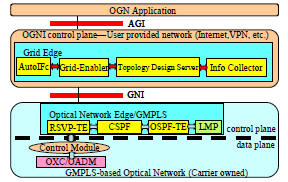
Fig. 1. Edge node architecture in the OGNI implementation.
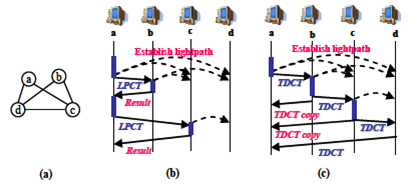
Fig. 2. OGN construction with LPCT and TDCT signaling schemes.
(a) the OGN topology, (b) LPCT scheme, (c) TDCT scheme
Reference
[1] G. Bernstein (ed.), draft-ietf-ccamp-rwa-wson-framework-01.txt
[2] G. Zervas, et al., “Phosphorus grid-enabled gmpls control plane (g2mpls): architectures, services, and interfaces,” IEEE Communications
Magazine, vol. 46, issue. 6, pp. 128-137, June 2008.

Biography:
Sugang Xu received his B.E. and M.E. degrees in computer engineering from Beijing Polytechnic University, Beijing, China, in 1994 and 1997, respectively, and Ph.D. degree in information and communication engineering at the University of Tokyo, Tokyo, Japan, in 2002. He joined the Global Information and Telecommunication Institute, Waseda University in 2002, as a research associate there. Since 2005, he joined National Institute of Information and Communications Technology (NICT), Tokyo, Japan, as an expert researcher. His research interests include algorithms, network architectures, photonic network control, optical grid network systems, parallel and distributed processing. He received the IEEE APB-APCC 2000 Best Paper Award in 2000, the IEICE Communications Society Conference English Section Best Paper Award in 2004. He is a member of the IEICE and IEEE.
1-3 "Network Virtualisation for Packet Optical Networks"
Adrian Farrel, Daniel King, Old Dog Consulting, UK
 “Network virtualisation” and “packet optical networks” are some of the latest buzz words in
telecommunications and network planning. The combination of these concepts can produce a powerful
and cost-efficient way to operate networks and to get the best value from high-capacity optical
transport systems.
“Network virtualisation” and “packet optical networks” are some of the latest buzz words in
telecommunications and network planning. The combination of these concepts can produce a powerful
and cost-efficient way to operate networks and to get the best value from high-capacity optical
transport systems.
But optimal planning and operation of a packet optical network is not straight forward. Simply
dedicating lambdas to build a full mesh of virtual connections between all routers enables a high
degree of optimality in the packet network, but is very wasteful of resources in the optical network. On
the other hand, re-aggregating packet traffic at every hop through the transport network is costly both
in terms of routing hardware and optical termination equipment.
This presentation will show how there is a commercial and operational trade-off between connectivity
and aggregation, and will discuss how to determine where aggregation should occur as well as how
these points can be dynamically moved within the network as traffic demand varies.
Optical network operators can open substantial new revenue streams by simultaneously supporting
multiple client packet networks. We will show how network virtualisation together with MPLS-TE
aggregation techniques can leverage optical resources and enable increased traffic loads across the
core network.
Daniel King is an active contributor and author within the IETF's PCE and CCAMP working groups.
He co-authored RFC 4687 on OAM for P2MP MPLS. Daniel has wide experience of packet and
optical networks, having worked at a variety of vendors, and he was a founder of path computation
specialists Aria Networks. He is now an independent consultant with Old Dog Consulting.

Biography:
Adrian Farrel is an active participant in the IETF and has co-authored many RFCs and Internet-Drafts. He is currently one of two IETF Routing Area Directors where he has the additional responsibility for the MPLS Transport Profile
(MPLS-TP) effort. Adrian was previously co-chaired of the CCAMP, PCE, and L1VPN working groups.
Adrian has been at the forefront of development of solutions for multi-domain traffic engineering for a number of years.
Adrian has authored/edited five books on Internet protocols, and is a frequent presenter at commercial and academic conferences. He runs Old Dog Consulting, specialising in MPLS, GMPLS, and IP routing.
1-4 "Seamless Interconnection of Transport Networks"
Tomonori Takeda, Ryuta Sugiyama, Ichiro Inoue, and Kohei Shiomoto, NTT, Japan
 This presentation addresses benefits, requirements, technology development, and future directions for seamless
interconnection of transport networks for end-to-end service.
This presentation addresses benefits, requirements, technology development, and future directions for seamless
interconnection of transport networks for end-to-end service.
Currently, various new transport networks are investigated, such as WSON (Wavelength Switched Optical
Network), MPLS-TP, and PBB-TE. It is expected that these technologies will be deployed on a small scale at
the start, and will co-exist with existing transport networks, such as SONET/SDH. For example, MPLS-TP,
PBB-TE may be deployed in the access/aggregation network, ROADM in the metro, and WDM in the core.
Here a challenge is how to interconnect these various transport networks for end-to-end services. Usually, this
type of interconnection is not directly achieved at the transport layer. There are service networks on top of
transport networks, which act as bridges of various transport networks. For example, IP routers are placed at the
border of aggregation-and-metro, and metro-and-core, and terminate transport paths for IP forwarding.
However, there are several benefits for seamless interconnection at the transport layer, such as:
- No need to place service specific nodes at every border of transport technologies. For example, early
deployment of a service network may place service nodes at the border of metro-and-core, which mandates
transport path across aggregation and metro.
- Use of reliable transport connection as much as possible.
One potential solution is to deploy a single transport technology across all areas, eliminating the need for
interconnecting different technologies. Although this may be ideal, there are several drawbacks, such as cost
optimization.
Therefore, it would be attractive to interconnect various transport networks, via a “thin” layer. Requirements
from carrier perspective for such “thin” layer include scalability, reliability, quality of service (e.g., delay,
bandwidth), manageability (e.g., provisioning speed and complexity, end-to-end monitoring), and support of
multiple services.
Candidates for “thin” layer basis are Ethernet and MPLS/PW. On the Ethernet side, for example, MEF E-NNI is
being specified as interconnection of multiple domains at the Ethernet level. On the MPLS/PW side, for
example, MS-PW is being specified as interconnection of multiple domains at the PW level. This presentation
analyzes technology development of these relevant technologies. Furthermore, this presentation proposes future
directions to address requirements from carrier perspective, including expectations for standardization.


Biography:
Tomonori Takeda received the B.E. and M.E. degrees from Waseda University, Tokyo. Currently, he is with NTT Network Service Systems Laboratories, where his work is focused on IP optical network architecture and related protocols. He has been involved in standardization activities, and co-chaired the Layer 1 Virtual Private Network (L1VPN) working group in the IETF (2005-2009).
|
| Poster Session |
|
@Exhibition room
Thursday 11, June 2009 15:05-16:20
P-1 "Sharing Regenerators in All-Optical Routing"
Giovanni Fiaschi and Gianmarco Bruno, Ericsson Telecomunicazioni, Italy
 Physical impairments force the use of regeneration sites on long lightpaths in transport optical
networks. As the regenerator represents a noticeable cost in the network design and operation, it
is recommended to keep low their number. Node architectures, like Wavelength Selective
Switches, introduce flexible and scalable ways of switching in the optical domain: this encourages
the consideration of all-optical technologies in meshed topologies when feasible.
Physical impairments force the use of regeneration sites on long lightpaths in transport optical
networks. As the regenerator represents a noticeable cost in the network design and operation, it
is recommended to keep low their number. Node architectures, like Wavelength Selective
Switches, introduce flexible and scalable ways of switching in the optical domain: this encourages
the consideration of all-optical technologies in meshed topologies when feasible.
The application of lightpath routing to meshed topologies encourages the sharing of
optical transmission resources among several lightpaths. Hence, optical restoration schemes with
wavelength sharing have already been proposed in literature [1] and considerable advantages
can be obtained by sharing regenerators between several lightpaths. In these shared wavelength
restoration schemes, this may represent a further saving in the number of regenerators. Moreover,
a set of unrelated lightpaths that are partly routed on common resources may share the
regenerator sites. Even if different wavelengths require each its own regenerator, regenerators
sharing the same site may advantageously use common mechanical arrangements, with both
capex and opex improvements.
All-optical routing in meshed networks in practice has been introduced only recently.
Although theoretical studies have been proposed since several years ago, practical problems,
such as the planning of the regenerator sites, have not yet been solved, to the best of our
knowledge. A method will be presented here to solve the problem of efficient regeneration
location, allowing sharing of regenerators among several lightpaths. Appropriate wavelength
assignment schemes [2] often suggest using the same wavelength for non-overlapping lightpaths.
The same schemes can be used to choose the single wavelength used for the restoration of several
lightpaths in a shared wavelength restoration scheme. Once two paths to be activated
alternatively (such as restoration path of different services) share the same wavelength, they can
also share regeneration devices.
The described method value plans the regenerator locations in such a way that the total
number of regenerators is minimized, thus reducing the global cost of the network. As noted
above, the same scheme can be applied to sets of lightpaths sharing part of their route, but
activated simultaneously, hence using different lambdas. The integration of several regeneration
devices in a single mechanical arrangement is the related advantage. This will become even more
attractive through the development of new technologies like photonic integrated circuits.
[1] S. (Ramu) Ramamurthy, L. Sahasrabuddhe, and B. Mukherjee, “Survivable optical WDM
networks,” IEEE/OSA Journal of Lightwave Technology, vol. 21, no. 4, pp. 870-883, April
2003
[2] H. Zang, J. P. Jue, and B. Mukherjee, “A Review of Routing and Wavelength Assignment
Approaches for Wavelength-Routed Optical WDM Networks”, Optical Networks Magazine,
Jan 2000

Biography:
Gianmarco Bruno was born in Busalla in 1972 and received the Dr. Ing. degree in electronic engineering cum laude from the University of Genova, Italy, in 1999.
He has been working with Ericsson (formerly Marconi plc) in the Optical Network Development Unit in Genova, since 2000.
His interests are in the field of WDM optical transmission, network modeling and optimization.
He is author of several publications and patents in the field of network design, subsystem control and monitoring.
Since 2007 he has also been contributing to physical layer standardization at ITU-T.
P-2 "Dynamic Wavelength Allocation and Selection for Optical Network with Centralized Multi-Carrier Light Source"
Yueping Cai, Eiji Oki, Motoharu Matsuura, Naoto Kishi, and Tetsuya Miki, University of Electro-Communications, Japan
 This presentation addresses our proposed optical broadcast-and-select network
architecture with centralized multi-carrier light source (C-MCLS). A large number of optical
carriers/wavelengths generated by C-MCLS are distributed to all network nodes, which select and
modulate wavelengths to realize transmission, as shown in Fig. 1. To utilize wavelength resources
efficiently, we introduce a framework of wavelength allocation and selection (WAS). Wavelength
allocation is performed at a wavelength control server, while wavelength selection is done at each
network node according to wavelength allocation results. Both static and dynamic schemes are
adopted and implemented for WAS. By using fixed or tunable band pass filter and periodical
arrayed waveguide grating demultiplexer, wavelengths are selected and utilized by network nodes in
a static or dynamic manner. We evaluate network cost and performance of the proposed network.
Cost analysis and numerical results show that it offers greatly reduced cost compared to the
conventional one when the number of required access wavelengths at network nodes becomes large.
We delineate its applicable areas through cost comparisons. Blocking probabilities of static and
dynamic schemes are analyzed to evaluate network performance. Numerical results show that by
choosing appropriate design parameters, the dynamic scheme offers about 25% increase in
admissible offered load under the specified blocking probability, compared to the static scheme. This
indicates that the dynamic scheme makes the proposed network more robust against traffic
fluctuations.
This presentation addresses our proposed optical broadcast-and-select network
architecture with centralized multi-carrier light source (C-MCLS). A large number of optical
carriers/wavelengths generated by C-MCLS are distributed to all network nodes, which select and
modulate wavelengths to realize transmission, as shown in Fig. 1. To utilize wavelength resources
efficiently, we introduce a framework of wavelength allocation and selection (WAS). Wavelength
allocation is performed at a wavelength control server, while wavelength selection is done at each
network node according to wavelength allocation results. Both static and dynamic schemes are
adopted and implemented for WAS. By using fixed or tunable band pass filter and periodical
arrayed waveguide grating demultiplexer, wavelengths are selected and utilized by network nodes in
a static or dynamic manner. We evaluate network cost and performance of the proposed network.
Cost analysis and numerical results show that it offers greatly reduced cost compared to the
conventional one when the number of required access wavelengths at network nodes becomes large.
We delineate its applicable areas through cost comparisons. Blocking probabilities of static and
dynamic schemes are analyzed to evaluate network performance. Numerical results show that by
choosing appropriate design parameters, the dynamic scheme offers about 25% increase in
admissible offered load under the specified blocking probability, compared to the static scheme. This
indicates that the dynamic scheme makes the proposed network more robust against traffic
fluctuations.

Fig.1. Network architectures based on different light sources.

Biography:
He received B.E. and M.E. degrees in computer science and technology from Chongqing University, Chongqing, China, in 2003 and 2005, respectively. He is currently working towards the Ph.D. degree with the department of information and communication engineering, the University of Electro-Communications, Tokyo, Japan. He was an internship student of NTT Tokyo Musashino R&D research center in the summer of 2004. He joined the optical network division of the advanced technology department, Huawei Technologies, China as a research engineer after master graduation. His research interests include: optical burst switching network, optical waveband switching network, multi-carrier light source based optical network architectures, and GMPLS based network control and management.
P-3 "DWDM aware Control Plane"
Gabriele Maria Galimberti, Cisco Systems Italy, and Mitsuru Ayatani, Cisco Systems G.K., Japan
 Generalized Multi-Protocol Label Switching (GMPLS) applied to wavelength switched optical
networks (WSON) needs to address specific issues related to optical technologies. The
framework of GMPLS addresses specific issues related to transparent optical networks and to
the Routing and Wavelength Assignment (RWA) problem. One of the key aspects while dealing
with transparent DWDM optical networks are the physical impairments incurred by non-ideal
optical transmission media and how they accumulate along an optical path.
Generalized Multi-Protocol Label Switching (GMPLS) applied to wavelength switched optical
networks (WSON) needs to address specific issues related to optical technologies. The
framework of GMPLS addresses specific issues related to transparent optical networks and to
the Routing and Wavelength Assignment (RWA) problem. One of the key aspects while dealing
with transparent DWDM optical networks are the physical impairments incurred by non-ideal
optical transmission media and how they accumulate along an optical path.
The problem is that optical layer transmission impairments are usually not considered when
establishing a light path in a transparent/translucent optical network and GMPLS (as is) is not
sufficient to decide whether a proposed path is feasible in the photonic domain (no Optical
Impairment Calculation)
In this presentation, to provide parameters of optical impairments to be considered to assess the
feasibility of an optical path. We also discuss and show evaluation results of different
approaches in implementing Optical Channel Provisioning functionality in an optical network
taking into account physical impairments. And we identify and introduce a new intermediate
layer (OCP - Optical Control Plane) while providing protocol interoperability with the GMPLS
suite.
Followings are our presentation agenda;
- Control Plane for DWDM networks: general goals
- CP Architecture and Linear Impairments management
- Non Linear Impairments management
- Regenerators support
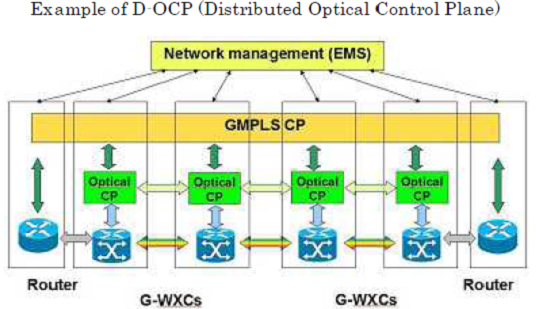

Biography:
Mitsuru Ayatani is consulting system engineer in technical consulting group at Cisco Systems Japan.
He is responsible for cisco optical products and those technologies.
He has more than 20 years experience for optical transmission industry through HP, Agilent and Cisco systems.
Gabriele Galimberti graduated at Politecnico di Milano in Electronic Engineering (laurea in Ingegneria Elettronica) in 1985.
After the Degree He joined Telettra Telecomunicazioni (acquired by Alcatel in 1991) Research and Development department where He worked on the Transmission Equipment design. Other than PDH design, He focused on the Architecture and development of the SDH equipments family and contributing to the SDH standards refinements.
He had an experience on DWDM systems development and the Packet over Sonet applications.
Gabriele joined the Engineering department of Cisco Photonics, Monza, Italy in 2000 where his main activities are now focused on Optical Systems Architecture and Optical Control Plane Architecture and design. Is actively involved in IPoDWDM Architecture definition.
Some white papers on the Optical Control Plane are:
A Study of Connection Management Approaches for an
impairment-aware Optical Control Plane
Elio Salvadori1, Yabin Ye1, Andrea Zanardi1, Hagen Woesner1, Matteo Carcagni1
Gabriele Galimberti2, Giovanni Martinelli2, Alberto Tanzi2, Domenico La Fauci2
Towards Deployment of Signalling based Approaches for Impairment
Aware Lightpath Setup in Transparent WDM Optical Networks
Elio Salvadori (1), Chava Vijaya Saradhi (1), Yabin Ye (1), Andrea Zanardi (1), Matteo Carcagni (1), Gabriele
Galimberti (2), Giovanni Martinelli (2), Alberto Tanzi (2), and Domenico La Fauci (2)
Signalling-based architectures for impairment aware
Light path set-up in GMPLS networks
Elio Salvadori1, Yabin Ye1, Andrea Zanardi1, Hagen Woesner1, Matteo Carcagni1,
Gabriele Galimberti2, Giovanni Martinelli2, Alberto Tanzi2, Domenico La Fauci2
Physical Layer Impairment (PLI) Aware Transponder
Selection Policies for GMPLS/WDM Optical Networks
Chava. V. Saradhi1, M. Carcagni1, E. Salvadori1, Y. Ye1, A. Zanardi1, G. Galimberti2, G. Martinelli2, A.
Tanzi2, D. La Fauci2, S. Piciaccia2
P-4 "GMPLS Requirement for Optical Physical Impairment Management and Control in WSON"
Jianrui Han and Jianhua Gao, Huawei, China
 In Transparent WDM optical network, signals are transported end to end optically
without OEO operation. So transmitted signal will experience physical impairments
like CD,PMD,OSNR that will accumulate along the light path. Based on the physical
layer impairment estimation and monitor techniques, several impairment aware
routing and wavelength assignment (IA-RWA) algorithms have been proposed. In this
presentation we will give some analysis about the requirement for the optical physical
impairment management and control from the GMPLS control plan perspective.
In Transparent WDM optical network, signals are transported end to end optically
without OEO operation. So transmitted signal will experience physical impairments
like CD,PMD,OSNR that will accumulate along the light path. Based on the physical
layer impairment estimation and monitor techniques, several impairment aware
routing and wavelength assignment (IA-RWA) algorithms have been proposed. In this
presentation we will give some analysis about the requirement for the optical physical
impairment management and control from the GMPLS control plan perspective.
To set up an end to end available light path successfully, control plan should consider
the physical impairment information of WSON network. There are two main
mechanisms to deal with the physical impairment information.
Firstly, control plane can consider physical impairment information at path
calculation phase. For a given wavelength route, we can estimate the impairment
effects via approximation techniques based on some mature mechanisms described in
ITU-T standards such as G.680. According to the estimated result, we can make a
decision whether the route is available or not.
Secondly, control plane can consider physical impairment information at path setting
up phase. Some monitoring techniques used to determine the quality of optical
channels within an optical core network have been presented in some paper. These
techniques can be divided into optical impairment monitoring (OIM) techniques (such
as CD, PMD and OSNR monitoring) and optical performance monitoring (OPM)
techniques (which covers bit-error monitoring and Q-value monitoring primarily, i.e.
methods for direct signal quality estimation). The monitor result of these monitoring
techniques can be used to verify whether the light path can meet with the end to end
signal quality requirement. If not, a new light path will be attempted.
In this presentation, we will give some analysis of application scenarios from the
GMPLS control plan perspective. Based on the analysis, we will describe the
requirement on the interface between control plan and Optical Layer Parameters.
Furthermore, we will describe how control plan combines above estimation and
monitoring techniques to deal with the physical impairment information when setting
up an end to end light path in WSON network.

Biography:
Jianrui HAN, a senior engineer, in Advanced Technology Department of Wireline Network Business Unit of Huawei Technologies Co., Ltd., She joined Huawei in 2001. Originally as a software programmer and project leader working on host software of WDM product. her work is currently focus on the GMPLS control plane, PCE and particularly the control and management technologies for photonic networks.
P-5 "Effective Recovery schemes for Wavelength Switched Optical Networks (WSON) "
Daniele Ceccarelli and Diego Caviglia, Ericsson Telecomunicazioni, Italy
 Implementations ofWSON need to satisfy the carrier’s requirements in terms of recovery schemes; these
requirements can be summarized in higher availability using fewer resources.
In this presentation two recovery schemes are presented, namely the 3-WAY and the Safe-OSNCP. Those
schemes can be used both to improve the overall network availability and to reduce the resource used.
Implementations ofWSON need to satisfy the carrier’s requirements in terms of recovery schemes; these
requirements can be summarized in higher availability using fewer resources.
In this presentation two recovery schemes are presented, namely the 3-WAY and the Safe-OSNCP. Those
schemes can be used both to improve the overall network availability and to reduce the resource used.
The 3-WAY and Safe-OSNCP protection schemes are both able to provide 2 fault resiliency. Moreover the
former allows protection resource sharing and the latter 50ms switching time for double failure recovery.
The 3-WAY mechanism is based on an O-SNCP like switching method. One transponder is connected to a
dedicated working path while the second one is connected, when needed, to one of two reserved protection
paths. Such paths are not cross-connected until the working path fails so to give the possibility of sharing
them with other working paths. The drawback generated by sharing protection resources consists on an
increase of the recovery time.
(fig.1) P-A1 and P-A2, protection paths of workingW-A, share expensive resources like
regenerators, with P-B1 and P-B2, that are the protection paths with respect to working W-B.
On the other hand the Safe-OSNCP (fig.2) mechanism provides protection to two
different faults guaranteed a switching time equal o less than 50 ms. The immediate
availability of resources leads to the drawback of not being able to share them.
The Safe OSNCP is based on three fully disjoint paths, each of them with a different
associated cost:
- W-Priority 0-(Highest priority)
- P1-Priority 1
- P2-Priority 2-(Lowest priority)
An O-SNCP is set up between a transponder connected with the
dedicated working path and a transponder connected to a dedicated
protection path. At any failure/healing occurrence the protection is reoptimized
generating a new O-SNCP between the less expensive paths among
the available ones following a dedicated algorithm.
The presentation will also illustrate resource utilization for the different
recovery schemes compared with the achieved availability.
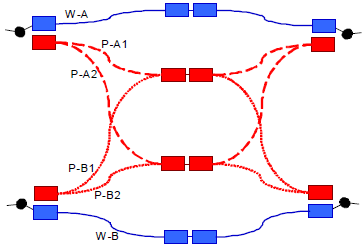
Figure 1 - 3-WAY
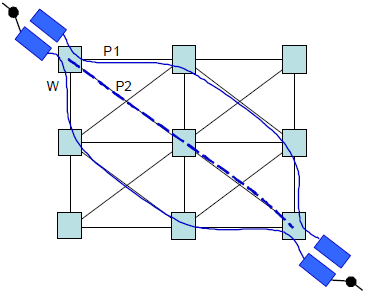
Figure 2 - Safe OSNCP

Biography:
Diego is working in the standardization arena since beginning of 2000, he's been active in IETF and OIF.
He's co-author of several IETF Internet-Drafts and some RFCs, for the OIF he's been the technical contact point for OIF Interoperability events.
Diego, with respect the standardization activity, is toady working on WSON and MPLS-TP topic.
Diego has been the technical lead for the Marconi/Ericsson GMSPL project today as Ericsson employee Diego has the responsibility as Product Manger for the High Order SDH product family, the planning tools and the Optical Core Solution.
P-6 "MPLS-TP and IP/MPLS Interworking"
Riccardo Martinotti and Diego Caviglia, Ericsson Telecomunicazioni, Italy
 MPLS-TP is a joint ITU-IETF effort to include a MPLS Transport Profile within the IETF MPLS
architecture to support the capabilities and functionalities of a packet transport network as defined by
ITU-T. In the MPLS-TP requirements (draft-jenkins-mpls-mpls-tp-requirements) it is highlighted that
an MPLS-TP architecture must allow interworking with new and already deployed IP/MPLS networks.
MPLS-TP is a joint ITU-IETF effort to include a MPLS Transport Profile within the IETF MPLS
architecture to support the capabilities and functionalities of a packet transport network as defined by
ITU-T. In the MPLS-TP requirements (draft-jenkins-mpls-mpls-tp-requirements) it is highlighted that
an MPLS-TP architecture must allow interworking with new and already deployed IP/MPLS networks.
Purpose of this presentation is to illustrate the most likely interworking scenarios between MPLS-TP
and IP/MPLS. For each of the examined scenario interworking limitations, issues and open points,
with particular focus on OAM capabilities, are provided.
The main architectural construct considered in this presentation foresees PWE3 protocol Stack
Reference Model, however also MPLS Protocol Stack Reference Model is considered.
This presentation is based on the IETF draft draft-martinotti-mpls-tp-interworking.
The following scenarios will be illustrated:
- Network Layering
- Layering is done by means of Ethernet encapsulation over MPLS-TP via PW (Ethernet is
Server layer of IP/MPLS)
- IP/MPLS encapsulation over MPLS-TP via PW
- Transparent transport of IP/MPLS
- MPLS-TP edge node is LSR of IP/MPLS
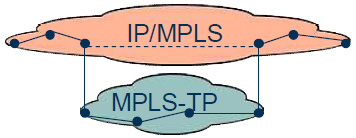
- Network Partitioning
- Partitioning is done is done by means of a Border
Node with interfaces on both the IP/MPLS and
MPLS-TP networks
- Multisegment Pseudowires
- LSP Stitching

- Partitioning is done is done by means of a Border Link connecting the IP/MPLS and MPLS-TP
networks
- Multisegment Pseudowires
- LSP Stitching

Examples of Network Applications will be provided for both scenarios.
Recommendations for the preferred options will be provided too.

Biography:
Diego is working in the standardization arena since beginning of 2000, he's been active in IETF and OIF.
He's co-author of several IETF Internet-Drafts and some RFCs, for the OIF he's been the technical contact point for OIF Interoperability events.
Diego, with respect the standardization activity, is toady working on WSON and MPLS-TP topic.
Diego has been the technical lead for the Marconi/Ericsson GMSPL project today as Ericsson employee Diego has the responsibility as Product Manger for the High Order SDH product family, the planning tools and the Optical Core Solution.
P-7 "PCE Application for ASON Network"
Fatai Zhang, Jianhua Gao, and Dan Li, Huawei, China (Speaker:Qiming Li, Huawei, China)
 IETF PCE Working Group keeps making progress on PCE related standards, which makes the
PCE technology getting ready for commercial implementation. In this presentation, several
scenarios that PCE is applied to ASON network are described, and the PCEP extension to satisfy
a Path Query for the LSP in ASON network is also discussed.
IETF PCE Working Group keeps making progress on PCE related standards, which makes the
PCE technology getting ready for commercial implementation. In this presentation, several
scenarios that PCE is applied to ASON network are described, and the PCEP extension to satisfy
a Path Query for the LSP in ASON network is also discussed.
With more and more commercial TDM based ASON network have been deployed, the need that
PCE is applied in ASON network becomes more and more urgent. However, because of more
traffic engineering constraints, there are still some gaps should be made up for PCE applied in
ASON network.
First, the natural properties related to the LSP being computed should be fed to PCE from PCC.
These natural properties include the switching capabilities (e.g., TDM, lambda, LSC, etc),
encoding type (e.g., SDH/Sonet, Digital Wrapper, lambda, etc) and signaling type (e.g., VC12,
VC3, ODUk, etc). This information is very important for PCE to compute a required Path.
Second, the reliability is very important for ASON transport network. So the PCE should get the
LSP protection information from PCC. In ASON network, there are abundant protection types to
satisfy different demand for the service, for example, 1+1 protection, 1:1 protection, 1: n
protection, full rerouting, shared-mesh restoration, and segment recovery, etc. This information
is really important for PCE to compute the corresponding work LSP and protection LSP
correctly.
Third, in ASON network (e.g., SDH/OTN ASON network), there are specific traffic
characteristics for the specific service. For example, in the SDH ASON network, if the client
service which is 100M Ethernet is required to be transported over the SDH networks, the
Ethernet service can be provided by a VC4 LSP, and it can also be provided by three
concatenated VC3 (Contiguous or Virtual concatenation). So these traffic characteristics of the
service are vital for PCE to compute the correct LSP to transport the service flow.

Biography:
Qiming Li, Research Engineer, Advanced Technology Department of Wireline Network Business Unit of Huawei Technologies Co., Ltd. He joined Huawei in 2004 and has been engaged in research on the GMPLS control plane field, IP optical network architecture and related protocols.
P-8 "PCE in Multi-Layer Networks IP/MPLS over WSON"
F. Cugini, CNIT, N. Andriolli, A. Giorgetti, F. Paolucci, L. Valcarenghi, P. Castoldi, Scuola Superiore Sant'Anna, P. Iovanna, and A. Welin, Erricson Research, Italy
 In the context of GMPLS, a multi-layer network (MLN) consists of transport nodes with interfaces operating
at multiple data plane layers of either the same or different switching technology and controlled
by a single GMPLS control plane instance. In this talk we focus on two-layer MLN, where the upper layer
has Interface Switching Capability (ISC) of type Packet Switching Capable (PSC) and the lower layer has ISC
of type Lambda Switching Capable (LSC). In particular, the lower-layer is a Wavelength Switched Optical Network (WSON),
where dynamic connection provisioning requires complex and effective Routing and Wavelength Assignment (RWA) schemes
taking into account both bandwidth availability and wavelength continuity constraints. Moreover,
specific WSON information and attributes (e.g., physical impairments) may significantly complicate the path computation
and their values may not be updated or fully available.
In the context of GMPLS, a multi-layer network (MLN) consists of transport nodes with interfaces operating
at multiple data plane layers of either the same or different switching technology and controlled
by a single GMPLS control plane instance. In this talk we focus on two-layer MLN, where the upper layer
has Interface Switching Capability (ISC) of type Packet Switching Capable (PSC) and the lower layer has ISC
of type Lambda Switching Capable (LSC). In particular, the lower-layer is a Wavelength Switched Optical Network (WSON),
where dynamic connection provisioning requires complex and effective Routing and Wavelength Assignment (RWA) schemes
taking into account both bandwidth availability and wavelength continuity constraints. Moreover,
specific WSON information and attributes (e.g., physical impairments) may significantly complicate the path computation
and their values may not be updated or fully available.
In the considered MLN, path computation is performed
by Path Computation Element (PCE) with visibility and responsibility either on all the layers or just on a single layer.
In the latter, cooperation between PCEs may be required to complete the connection setup.
In this talk we address several issues that may affect the overall Traffic Engineering (TE) performance in the considered scenario.
In particular we deal with scalability issues related to the presence of a single PCE versus one PCE per layer,
and considering either stateful or stateless conditions. Simulation results are provided in terms of resource utilization,
TE Database (TED) size and dynamicity in the information update. At the upper layer, the efficiency
in building the Virtual Network Topology (VNT) as a combination of both Forwarding Adjacencies LSPs (FA-LSPs)
and the Virtual TE links is considered. At the WSON layer, the main RWA schemes are considered, providing results
and considerations in case of both static and dynamic conditions.

Biography:
Alessio Giorgetti holds a Laurea degree in Telecommunications Engineering (2002) from the University of Pisa, Italy, and a Ph.D. degree (2006) from Scuola Superiore Sant'Anna, Pisa, Italy. He was a Visiting Scholar at CAPE, Cambridge, UK for one year (2007). He is currently a Postdoctoral Fellow at Scuola Superiore Sant'Anna.
His research interests include WDM networks design, fault tolerance in optical networks, GMPLS control plane for wavelength switched optical networks, next generation SONET/SDH technologies and WDM-PON access networks design.
|
| Technical Session |
|
Tech. Session 2: Impairment-aware routing for WSON
Thursday 11, June 2009 16:35-18:15
Chair: Tomonori Takeda, NTT, Japan
2-1 "PCE-based Approaches to TED Creation and Maintenance for support of Impairment-aware RWA (IA-RWA) in Wavelength Switched Optical Networks (WSON)"
Young Lee, Huawei, and Greg Bernstein, Grotto Networks, USA
 ROADM-based wavelength switched optical networks (WSON) have been deployed in carrier’s networks
in a rather fast pace than anticipated due to explosive traffic demand, the standard bodies like IETF have
begun investigation to be able to provide control plane solutions for WSON [WSON-Frame]. Control of
WSON, however, has a number of new factors to be considered due to the unique properties of WSON.
ROADM-based wavelength switched optical networks (WSON) have been deployed in carrier’s networks
in a rather fast pace than anticipated due to explosive traffic demand, the standard bodies like IETF have
begun investigation to be able to provide control plane solutions for WSON [WSON-Frame]. Control of
WSON, however, has a number of new factors to be considered due to the unique properties of WSON.
Firstly, WSON requires complex path computation resource than typical path computation in IP/MPLS
networks. WSON includes unique routing constraints such as RWA, wavelength continuity constraint,
and impairment such as power, OSNR, CD, etc.
Secondly, the routing information required to enable impairment-aware RWA in WSON is enormous
compared to typical TED information for IP/MPLS networks [WSON-INFO]. Additional routing
information in WSON includes: (i) switch connectivity information of ROADM (ii) wavelength
availability information (aggregated TE information is not sufficient for routing in WSON as RWA
requires the exact wavelength link usage information); (iii) link and node impairment information.
The primary standardized method for creating and maintaining a TED for any networking technology
utilizes a link state protocol such as OSPF or IS-IS along with extensions [GMPLS]. Note that all
participants in the link state protocol will maintain a TED and by the nature of the current protocols all
these TEDs will contain the same information when in a stable state.
This paper presents alternative methods for creating and maintaining a TED. In the link state routing
scenario previously described we see that every switching node maintains a complete TED. This is due to
both the design of the routing protocols and the notion, prior to the development of the PCE architecture,
that every node would need to perform path computation, i.e., would serve as a PCE. At the opposite
extreme when a management system performed path computation, only it keeps a complete TED suitable
for RWA. This leads to the not so surprising observation that only PCE's need complete TEDs.
Hence if we want to reduce the burden on both switching nodes in processing and storing the TED, and
the control plane communication channel in carrying TED related information, we should restrict the flow
of TED related information to flow from the nodes that have direct knowledge of this information to the
PCEs that need to create and maintain the complete TED for the network.
There are three general approaches based on where nodes send their local TED information: (a) Nodes
send local information to all PCEs; (b) Nodes send local information to an intermediate server that will
send to all PCEs; (c) Nodes send local information to only one PCE and have the PCEs share this
information with each other. The key idea in reducing the burden on the optical switching nodes and the
control communication channels was to only assemble and maintain the complete information set at its
points of use, the path computation elements (PCEs).
References
[PCE] Farrel, A., Vasseur, J.-P., and J. Ash, "A Path Computation Element (PCE)-Based Architecture", RFC 4655, August 2006.
October 2004.
[GMPLS] Kompella, K., Ed., and Y. Rekhter, Ed., "Routing Extensions in Support of Generalized Multi-Protocol Label
Switching (GMPLS)", RFC 4202, October 2005.
[WSON-Info] G. Bernstein, Y. Lee, D. Li, W. Imajuku, “ Routing andWavelength Assignment Information Model for
Wavelength Switched Optical Networks”, Work in progress: draft-ietf-ccamp-rwa-info-00.txt, August 2008.

Biography:
Young is currently Principal Technologist at Advance Technology Division, Huawei Technologies USA Research Center, Plano, Texas. He is leading optical transport control plane technology research and development. His research interest includes distributed path computation architecture, multi-layer traffic engineering methodology, and network optimization modeling and new concept development in optical control plane signaling and routing.
Prior to joining to Huawei Technologies, Young was a co-founder and a Principal Architect at Ceterus Networks (2001-2005) where he developed topology discovery protocol and control plane architecture for optical transport core product. Prior to joining to Ceterus Networks, Young was Principal Technical Staff Member at AT&T/Bell Labs in Middletown/Holmdel, New Jersey. At AT&T Labs (1996-2000), he was responsible for core IP/MPLS network architecture evolution and AT&T End-to-end architecture planning. He also involved voice/data convergence architecture planning and evolution. At Bell Labs (1987-1995), Young was responsible for developing dynamic routing schemes and traffic network management control and measurement development. He is currently active in IETF PCE and CCAMP WGs and is a co-author of RFC 3214. He holds several patents in the area of dynamic routing and switching technology and several patents pending in optical networking.
Young Lee received B.A. degree in Applied Mathematics from the University of California at Berkeley in 1986, M.S. degree in Operations Research from Stanford University, Stanford, CA, in 1987, and Ph.D. degree in Decision Sciences and Engineering Systems from Rensselaer Polytechnic Institute, Troy, NY, in 1996. He is a member of IEEE and Alpha Phi Mu honor society.
2-2 "Impairment Aware Routing and Wavelength Assignment in WSON: Processes, Architectural Options, and Constraints and Protocol Implications"
Greg Bernstein, Grotto Networks, Young Lee, Huawei, USA, and Dan Li, Huawei, China
 In this paper we will show how a network control plane utilizing extended GMPLS and PCE protocols
can accommodate impairment aware routing and wavelength assignment (IA-RWA) in optical networks.
In this paper we will show how a network control plane utilizing extended GMPLS and PCE protocols
can accommodate impairment aware routing and wavelength assignment (IA-RWA) in optical networks.
Optical impairments incurred by a signal traversing fiber and passing through each optical network
element along the path determine whether the BER performance or any other measure of signal quality
can be met for this particular signal on this particular path. Hence, optical impairments must always be
taken into account in some way in the path (RWA) computation process. Standardization of optical
impairments including definitions and test methods has been of primary concern of the ITU-T. Many of
these standards have been directed at particular components such as fibers, optical amplifiers and such.
However, more recently standards such as ITU-T G.680 have developed network level models (link and
node level) that more directly address impairment estimation along entire optical paths.
Control plane standards such as G.ASON and GMPLS have included optical networking in some form for
quite some time however have recently been extended to deal with the new generation of wavelength
selective optical networking (WSON) elements such as ROADMs, PXCs, and tunable lasers. Key aspects
of the enhanced GMPLS/PCE control plane for WSON includes modeling asymmetric switches, detailed
link wavelength usage status, and the use of PCE in various RWA computation architectures.
To leverage the previous work on optical impairment standardization and WSON control plane extensions,
we decompose IA-RWA into three major functions/processes: Impairment validation (IV), Routing (R),
and Wavelength Assignment (WA). We then further categorize practical IV processes that can be used
in IA-RWA. These include: (i) IV-Candidates: In response to a request for impairment valid paths
between two nodes the process furnishes an impairment acceptable list of candidate paths between two
nodes. (ii) IV-Distributed: Computes approximate impairment effects via the use of a signaling protocol
in a distributed manner. (iii) IV-Detailed: Performs detailed estimation of impact of impairments on a
particular path and wavelength being considered for addition to the network, and possibly the impact on
existing connections in the network.
Putting the RWA processes and IV processes together, we then investigate three overall IA-RWA control
plane alternatives: (a) Combined IV + RWA: Combines RWA and IV within a single computation entity
enabling highest potential optimality and efficiency in IA-RWA. (b) IV separate from RWA Allows
separation of impairment information into two computational entities while still maintaining a high
degree of potential optimality and efficiency in IA-RWA. (c) R with distributed IV and/or WA: Here
the signaling protocol is leveraged in the wavelength assignment process. We show how these alternatives
can be used to meet constraints on information sharing and impairment estimation accuracy and assess the
impact of these alternatives on signaling, routing, and the PCE communications protocol.

Biography:
Dr. Bernstein received his PhD (1988), MS (1984) and BS (1982) degrees in Electrical Engineering and Computer Science from the University of California at Berkeley. Dr. Bernstein is currently Chief consultant at Grotto Networking and is active in network standardization, network design, network equipment design and network research for a variety of customers. Previously he was a Senior Technology Director at CIENA Corporation looking over Network control and management architectures after directing all software development (embedded, control plane, management plane and management systems) at Lightera Networks (acquired by Ciena) where his team applied signaling and routing techniques to the control of networks of Lightera optical switches (now the Ciena CoreDirector) which have been deployed in large carrier networks world wide. Prior to the joining Lightera Networks, Dr. Bernstein was a senior manager at Northern Telecom, specializing in new product development. Dr. Bernstein has filed numerous US patents in the areas of optical networking, packetized voice, congestion control and encryption. Dr. Bernstein was previously involved in the development of a fiber based digital video distribution system and spread spectrum communication systems, and ran two DARPA sponsored advanced research contracts. Dr. Bernstein has authored one book on the control of optical networks, and many papers appearing in IEEE Communications Magazine, the Journal of Optical Networks, IEEE Transaction on circuits and systems, IEEE transactions on Communications, IEEE InfoCom and IEEE MilCom conferences. Dr. Bernstein has been involved with standards development at the IETF, OIF, ITU-T and ANSI Committee T1.
2-3 "Concurrent Impairments Aware Routing and Regenerator Location (PCE+) in a Wavelength Switched Optical Networks (WSON)"
Giulio Bottari and Diego Caviglia, Ericsson Telecomunicazioni, Italy
 WSON is a ongoing activity in IETF’s CCAMP and PCE working group which is currently addressing the
RWA (routing and wavelength assignment) constraint in optical networks. Lightpath provisioning in
WSONs requires a routing process where the provisioning of end-to-end lightpaths is typically unaware of
optical signal quality.
WSON is a ongoing activity in IETF’s CCAMP and PCE working group which is currently addressing the
RWA (routing and wavelength assignment) constraint in optical networks. Lightpath provisioning in
WSONs requires a routing process where the provisioning of end-to-end lightpaths is typically unaware of
optical signal quality.
Main goals of the WSON work is speed up the provisioning time via automated signaling and reduce the
cost of the network sharing resources, such as OEO and regenerator, that can be done applying the concept
of shared meshed restoration (RFC4427).
This new network paradigm imposes new challenge to both the planning and Path Computation Element
(PCE) processes.
In this presentation we’ll illustrate the concept of PCE+ that is a PCE also capable to optimally allocate the,
physical resources (e.g. OEO), giving as input the network topology and the traffic matrix. That is of
paramount importance in WSON networks given that the path feasibility is bounded to the availability of
OEO regenerator, compensator and so on.
In a first phase of the method, the network topology is partitioned in sections according to a deterministic
method. Each section is submitted to a PVE (Physical Validation Engine) which associates a set of quality
parameters to the section itself, storing these parameters in a static database (QoTDB).
Then, the PCE+ performs the path computation by processing a traffic matrix. The PCE+ operates on each
traffic matrix entry (traffic request) according to conventional routing algorithms (using Administrative
Cost as weight). In addition, the PCE+ uses an analytical method to check if the the path under
computation is likely to be physically feasible. This analytical method is performed using the data
contained in QoTDB.
At the end of the traffic matrix processing:
- The collection of traffic matrix entries, that have been routed by the PCE+ (being “physical
feasible” according the analytical check) are submitted to the PVE for a final and complete
physical check. Paths that does not pass the final check will be regenerated using a OEO placing
algorithm included in PCE+.
- The collection of traffic matrix entries, that have not been routed by the PCE+ (being “physical
unfeasible”), are submitted again to the PCE+ that now operates using the QoTDB data in a cost
formula (instead of Administrative Cost) finding the best OEO location to obtain a feasible path
for each traffic matrix entry.
The use of analytical methods applied to physical validation, in the routing phase, speeds up the path
calculation and allows the application in a dynamic network while ensuring the physical assessment of the
optical paths. In addition, regenerator location is performed by the same routing engine.

Biography:
Diego is working in the standardization arena since beginning of 2000, he's been active in IETF and OIF.
He's co-author of several IETF Internet-Drafts and some RFCs, for the OIF he's been the technical contact point for OIF Interoperability events.
Diego, with respect the standardization activity, is toady working on WSON and MPLS-TP topic.
Diego has been the technical lead for the Marconi/Ericsson GMSPL project today as Ericsson employee Diego has the responsibility as Product Manger for the High Order SDH product family, the planning tools and the Optical Core Solution.
2-4 "Impairment Compensation Control for Wavelength Switched Optical Networks"
Shoichiro Seno, Yoshimasa Baba, Eiichi Horiuchi, Teruko Fujii, and Sota Yoshida, Mitsubishi Electric, Japan
 The Wavelength Switched Optical Networks (WSON) framework with impairments [1] discusses how
Impairment Aware Routing and Wavelength Assignment (IA-RWA) in optical networks is supported by the Control
Plane with considerations on various impairments encountered by an optical path. It identifies major issues with
IA-RWA, such as impairment estimation, impairment information sharing, IA-RWA architectures, and implications to
the GMPLS (Generalized Multi-Protocol Label Switching) and PCE (Path Computation Element) protocols.
The Wavelength Switched Optical Networks (WSON) framework with impairments [1] discusses how
Impairment Aware Routing and Wavelength Assignment (IA-RWA) in optical networks is supported by the Control
Plane with considerations on various impairments encountered by an optical path. It identifies major issues with
IA-RWA, such as impairment estimation, impairment information sharing, IA-RWA architectures, and implications to
the GMPLS (Generalized Multi-Protocol Label Switching) and PCE (Path Computation Element) protocols.
To deal with various impairments, different types of impairment compensation technologies have been
developed. For example, chromatic dispersion may be compensated by dispersion compensation fiber (DCF) at a path’s
transient and receiver nodes, and it is also compensated by an electronic or optical compensator at its transmitter or
receiver node, as shown in Fig. 1. Insertion of 3R repeaters or an optical amplifier at a path’s transient nodes may also
be regarded as an effort of impairment compensation.
Although some compensation technologies offer fixed or limited compensation ranges against impairments,
technologies with wide and dynamically tunable compensation ranges have been developing. Such technologies are
especially suited for a dynamically established optical path because impairment compensation by them can be
automatically adjusted as adequate corresponding to a requested path’s impairments.
IA-RWA’s Impairment Validation (IV) process collects and evaluates impairments of a requested optical path,
and such information is essential for automatic adjustment of impairment compensation.
Based upon the above observation, we will discuss how various aspects of compensation control of tunable
compensation devices are handled by the GMPLS’s Control Plane based upon the WSON framework. It includes (i)
selection of compensation devices, (ii) initial setting of compensation parameters, and (iii) optimization of
compensation parameters. In (iii), compensation parameters will be tuned based on measurement results of sample
signal transmitted in the Data Plane. Such feed-back control can be realized by the Control Plane as shown in Fig. 2.
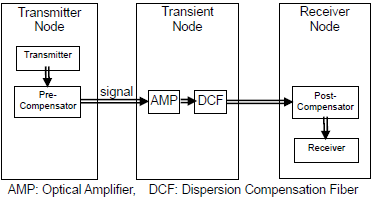
Figure 1 Impairment compensation for uni-directional signal along an optical path
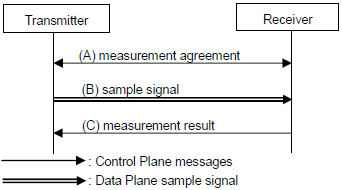
Figure 2 An impairment measurement process controlled by GMPLS
We will also address automatic discovery of link impairments for use by IA-RWA. Link impairments are basic
components of end-to-end impairments of an optical path, and their automatic discovery will be beneficial to the WSON
framework with impairments. Link impairment discovery will naturally follow neighbor discovery by LMP. It will be
realized by the same measurement process shown in Fig. 2 by using an extension of LMP.
We will conclude this presentation by report of a GMPLS-based implementation of the proposed impairment
compensation control procedure and link impairment discovery procedure. It will include a distributed IA-RWA
architecture with impairment compensation control and experimental results of link impairment measurement.
Reference
1. G. Bernstein et al, "A Framework for the Control and Measurement of Wavelength Switched Optical Networks (WSON) with Impairments," work
in progress: draft-bernstein-ccamp-wson-impairments-02.txt, IETF, Feb. 2009.

Biography:
Shoichiro Seno is currently a head researcher at Information Technology R&D Center, Mitsubishi Electric Corporation, Japan. He received his B.S. and M.S. degrees from Tokyo Institute of Technology and his Ph.D. from Aichi Prefectural University. Since joining Mitsubishi Electric Corporation in 1983, he has been engaged in R&D of LAN internetworking, high-speed protocol processing, multi-protocol router, network security, and optical network technologies such as GMPLS and ROADM.
|
Friday 12, June 2009
| Technical Session |
|
Tech. Session 3: GMPLS technologies and Testbed
Friday 12, June 2009 10:00-11:40
Chair: Sugang XU, NICT, Japan
3-1 "Plug and Play Techniques for GMPLS Network Configuration"
Kaori Shimizu, Rie Hayashi, Ichiro Inoue, and Kohei Shiomoto, NTT, Japan
 I. INTRODUCTION
I. INTRODUCTION
Large capacity and economical optical networks need to
have intelligent functions such as dynamic resource allocation
and efficient resource management: the best known example
is GMPLS (Generalized Multi Protocol Label Switching).
GMPLS requires IP to transport the signaling and routing
protocols over control plane. Therefore, to implement the
GMPLS network, it is necessary to set component parameters
for nodes and links and protocol operation parameters for
GMPLS protocols. This is so expensive that plug and play
techniques to set these parameters are needed.
II. PLUG AND PLAY TECHNIQUES
We propose plug and play techniques with automatic
parameter setting (Technique 1) and exchanging (Technique
2) for the component parameter configuration. The overview
of the plug and play techniques is shown in Fig. 1.
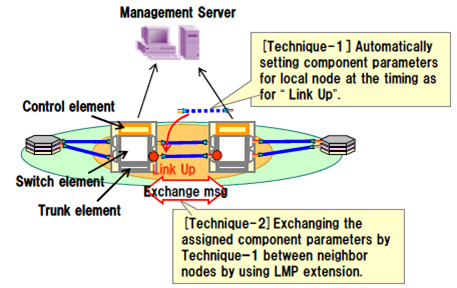
Fig.1 Overview of Plug and Play techniques
A. Auto configuration setting for local node’s parameters
(Technique 1)
Technique 1 enables GMPLS component parameters of a
local node to be set upon triggered by a link-up (optical cable
connection). The parameters are generated by the combination
of the previously assigned node identifier and unnumbered
link identifier. Therefore, the parameters are unique in the
network. For applying the proposed technique to all optical
equipments, we propose all optical node architecture with a
passive component and an active component for link-up
search. As shown Fig. 1, our proposed optical node has a N x
N all optical switch element as the passive element and a trunk
element as the active element. In this case, the proposed
optical nodes connect the switch port, which is connecting to
trunk element, to other switch port randomly for the link-up
search. The trunk element detects a link-up if the trunk port
connects to ports lead to the neighbor node and sends the
notification of link-up to a control element. When the control
element receives the notification, it generates the component
parameters of the local node.
B. Auto configuration exchanging for remote node’s
parameters (Technique 2)
Technique 2 enables GMPLS component parameters of a
remote node to be set by message exchange between neighbor
nodes. As the message, we use messages from an extended
version of LMP. The message is includes the local node
component parameters generated by Technique 1. The config
message is used as the exchange message for a control plane
interface and the test message is used for a data plane interface.
Therefore, the control element identifies whether the link-up
port is a control plane interface or a data plane interface.
III. IMPLEMENTATION AND EVALUATION
We implemented our proposed techniques in all optical
layer-1 nodes and evaluated the setup time of network
configurations in an evaluation network composed of three
layer-1 nodes. For the total twelve interface ports kept by
three layer-1 nodes, it took about 18 seconds to set up
component parameters of them. The proposed technique
automatically can generate all link parameters including
control channel link parameters and data channel link
parameters and reduce the number of operation man-hours
needed to establish the service. Fig. 2 shows a demonstration
of our techniques. We expect that LMP extension for our
proposed plug and play technique become a standard.

Fig.2 Demonstration of our proposed techniques

Biography:
Kaori Shimizu is a Research Engineer, Broadband Network Systems Project, NTT Network Service Systems Laboratories, where her work is focused on IP optical network architecture and related protocols. She received the B.S. degree from the University of Electro-Communications, Chofu, Tokyo.
3-2 "Extending the GMPLS Control Plane for Data Plane OAM configuration"
Attila Takacs, Ericsson Research, Hungary
 GMPLS is the unified control plane architecture for connection management over various data plane
technologies. It consists of a set of protocols: OSPF/ISIS-TE, RSVP-TE and LMP; which together reduce
manual configuration by automating provisioning, while still supporting centralized network management.
GMPLS technology adaptation is mostly concerned with the cross-connection of data plane resources, i.e.,
the definition of the generalized forwarding label and related procedures. However, there are additional
data plane functionalities that would benefit from automated single-sided provisioning.
GMPLS is the unified control plane architecture for connection management over various data plane
technologies. It consists of a set of protocols: OSPF/ISIS-TE, RSVP-TE and LMP; which together reduce
manual configuration by automating provisioning, while still supporting centralized network management.
GMPLS technology adaptation is mostly concerned with the cross-connection of data plane resources, i.e.,
the definition of the generalized forwarding label and related procedures. However, there are additional
data plane functionalities that would benefit from automated single-sided provisioning.
This talk will focus on how GMPLS can be used to automate the establishment and configuration of
Operations and Management (OAM) functions associated to connections.
OAM is essential to ensure that the desired service level of traffic engineered connections is met. In certain
technologies OAM entities are inherently established once the connection is set up. However other
technologies, especially OAM for packet switched networks (e.g., Ethernet PBB-TE, MPLS(-TP)), require
an extra configuration step after connection establishment to setup OAM entities. It would be desirable to
bind OAM setup to connection establishment signaling to avoid two separate management/configuration
steps (connection setup followed by OAM configuration) which increases delay, processing and more
importantly may be prone to miss-configuration errors.
In some situations the use of OAM functions, like those of Fault- and Performance Management, may be
optional depending on actual network management policies. Hence the network operator must be able to
choose which kind of OAM functions to apply to specific connections and with what parameters the
selected OAM functions should be configured and operated. To achieve this objective OAM entities and
specific functions must be selectively configurable. OAM functions are technology specific, i.e., vary
depending on the data plane technology. In addition for a given data plane technology a set of OAM
solutions may be applicable.
The GMPLS OAM configuration framework, introduced in this talk, will allow the selection of a specific
OAM solution to be used for the signaled LSP and provides technology specific information for detailed
configurations.

Biography:
Attila Takacs joined Ericsson Research in 2001. He has been working with inter- and intra-domain traffic engineering, resource management, and cross-layer optimization for media delivery systems. At present, his focus is on packet transport technologies and related GMPLS control plane aspects. He has a Master's degree in computer science and a post-graduate degree in banking informatics both from the Budapest University of Technology and Economics.
3-3 "A HoTNet Prototype in Test Bed"
Ning Yang, Xiaobing Zi, Yuanming Zheng, Qiming Li, and Hongmiao Xia, Huawei, China
 With the Internet traffic growing exponentially, the current backbone network faces
serious scaling and economic issues. In this presentation, we propose an approach
named HoTNet (Holistic Transport Network) to deal with above issues. The basic
idea of HoTNet is introducing the MPLS-TE fully meshed or OTN fully meshed
architecture to build backbone network, using the multi-layer planning tool to
optimize network resources statically, using the Bypass Server, Path Computation
Element (PCE) and Generalized Multi-Protocol Label Switching (GMPLS) to
optimize network resources dynamically. Theoretical analysis and network simulation
proved the HoTNet solution can bring TCO saving up to 40% for carriers in different
network architectures.
With the Internet traffic growing exponentially, the current backbone network faces
serious scaling and economic issues. In this presentation, we propose an approach
named HoTNet (Holistic Transport Network) to deal with above issues. The basic
idea of HoTNet is introducing the MPLS-TE fully meshed or OTN fully meshed
architecture to build backbone network, using the multi-layer planning tool to
optimize network resources statically, using the Bypass Server, Path Computation
Element (PCE) and Generalized Multi-Protocol Label Switching (GMPLS) to
optimize network resources dynamically. Theoretical analysis and network simulation
proved the HoTNet solution can bring TCO saving up to 40% for carriers in different
network architectures.
The prototype we implemented in test bed is based on emulate routers and
commercial OTN equipments, and introduced some new network elements such as
Bypass Server (BS) and Path Computation Element (PCE) to make bypass decision
and execution. With this prototype, we can demonstrate the whole traffic offloading
procedure which includes traffic monitoring, bypass decision, bypass link routing and
signaling in different layer coordinately, and service switching with
make-before-break. Through the automatic traffic offloading, carriers can cope with
the dramatically increased traffic by an OpEx effective way. The following figure
shows a simplified topology of HoTNet test bed:
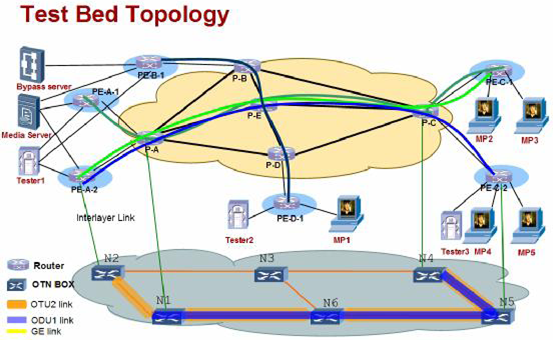

Biography:
Qiming Li, Research Engineer, Advanced Technology Department of Wireline Network Business Unit of Huawei Technologies Co., Ltd. He joined Huawei in 2004 and has been engaged in research on the GMPLS control plane field, IP optical network architecture and related protocols.
3-4 "Implementation of Web Services Based PCE and its Application for Inter-domain Advanced Services in 3TNet"
Yingdi Yu, Yaohui Jin, Yan Wang, Weiqiang Sun, Wei Guo, and Weisheng Hu, Shanghai Jiao Tong University, China
 Today, PCE-based routing model is believed to be the most suitable for path routing in the multi-domain ASON/GMPLS networks. At
the same time, with the increment of applications for home, enterprise and science computation, it is required for PCE to support more
advanced services, such as multicast, VPN and in-advance reservation etc. However, the extension to GMPLS protocols is not mature
to support such advanced services.
Today, PCE-based routing model is believed to be the most suitable for path routing in the multi-domain ASON/GMPLS networks. At
the same time, with the increment of applications for home, enterprise and science computation, it is required for PCE to support more
advanced services, such as multicast, VPN and in-advance reservation etc. However, the extension to GMPLS protocols is not mature
to support such advanced services.
In this presentation, we discuss the framework for implementation of Web Services (WS) based PCE. Web Services is a software
architecture that supports interoperable machine-to-machine interaction in network. In this architecture, services that will be required
by upper or peer applications are advertised with the description in Web Service Description Language (WSDL). The Simple Object
Access Protocol (SOAP) and Extensible Markup Language (XML) are taken for the machine-to-machine communications. Many
network interoperation architectures [1][2] have adopted Web Services in Optical Networks as it would bring several advantages:
- All functions are defined as services with universal interfaces. Details of internal implementation have been concealed.
- Both WSDL and XML provide flexibility. WSDL could describe new services in a machine readable way. XML could supports
extension in inter-machine communication easily.
- Standardized mechanisms for user authentication and policy management.
Fig.1 shows the architecture of the Web Service based PCE demonstrated in our prototype. For each domain, there is a Service Plane
that hosts all services, including Multicast, Optical Virtual Private Network (OVPN), In-Advance Reservation etc. These services are
accomplished by the cooperation among WS-PCEs and WS-TEDs. Web Services have been adopted in four cases as red lines show:
- PCCs require services by interacting with interfaces provided by WS-Gateway.
- Cooperation between WS-PCEs for inter-domain paths computation.
- WS-TEDs collect intra-domain Traffic Engineering (TE) information.
- Cooperation between WS-TED for inter-domain TE information advertising.
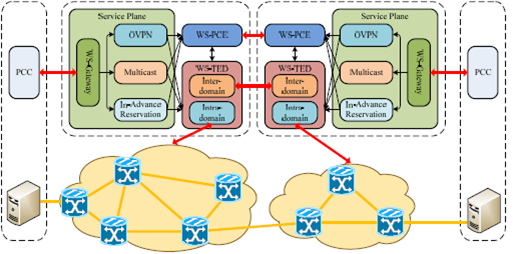
Fig. 1 Architecture of the Web Service based PCE
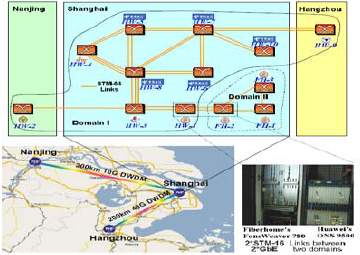
Fig. 2 Topology of 3TNet testbed
We have demonstrated inter-domain multicast, OVPN and in-advance reservation services mentioned above based on the Web Service
based PCE in 3TNet testbed [3][4]. Fig. 2 shows the optical network layer topology of the field trial network which is carried out in
Yangtze River Delta. There are 13ASON nodes located in two domains. In the data plane, all the ASON nodes are SDH cross-connects
provided by Huawei’s (ONS 9500) and Fiberhome’s (FonsWeaver 780) with at least 640 Gb/s non-blocking switching capacity. The
inter-networking point is located in the SJTU network center. 2 GbE and 2 STM-16 links connect two domains.
Reference:
[1]J. Lehman et al., “Control Plane Architecture and Design Considerations for Multi-Service, Multi-Layer, Multi- Domain Hybrid
Networks”, High-Speed Networks Workshop, INFOCOM 2007.
[2] B. St. Arnaud et al., “Customer-controlled and ?managed optical networks,” J. Lightw. Technol., vol. 21, no. 11, pp. 2804?2810,
Nov. 2003.
[3]J. Wang et al., “Field Trial of Inter-domain Point-to-multipoint Connections in ASON Using Web Service Mechanism”, OFC 2007.
[4]Y. Wang et al., “SOA-Based Inter-Domain OVPN Service for Coordinated Scheduling of Distributed Computing”, OFC 2008.

Biography:
Yingdi Yu is an Graduate student in the Department of Electronic Engineering at Shanghai Jiao Tong University (SJTU), China. He received his B.S. from the Honoured Class for excellent students at SJTU in 2007, and will receive his M.S. from the same university in 2010. His research interests include Multi-domain routing and signaling, Web-Service based network services provisioning.
|
| Technical Session |
|
Tech. Session 4: GELS and MPLS-TP for Ethernet transport technologies
Friday 12, June 2009 13:10-14:50
Chair: Adrian Farrel, Old Dog Consulting, UK
4-1 "Experiments of GMPLS based layer2 path control functions for next generation wide area layer2 networks"
Daisuke Ishii, Kou Kikuta, Masahiro Nishida, Yutaka Arakawa, Satoru Okamoto, and Naoaki Yamanaka , Keio University, Japan
 As increasing Ethernet service users and enhancing service functions, a next generation wide area layer2 network beyond
the state-of-the-art carrier grade Ethernet is expected. This presentation shows GMPLS controlled Next Generation Layer2
(NGL2) network. The presentation also shows the results of the experiment regarding with establishing a path in NGL2
network by RSVP-TE.
As increasing Ethernet service users and enhancing service functions, a next generation wide area layer2 network beyond
the state-of-the-art carrier grade Ethernet is expected. This presentation shows GMPLS controlled Next Generation Layer2
(NGL2) network. The presentation also shows the results of the experiment regarding with establishing a path in NGL2
network by RSVP-TE.
Figure 1 shows the architecture of our proposed NGL2 network. This network consists of a provider domain and user
domains. User Network Interface (UNI) supports various kinds of Ethernet frame and provides connection oriented
Point-to-Point/Point-to-Multipoint layer2 path service by setting up VLAN in response to users’ requests. In the provider
domain, User MAC frame from the user domain encapsulated into NGL2 MAC frame shown as Figure 2. The layer2 path is
identified by VLAN ID of NGL2 MAC frame. In the conventional VLAN, the same VLAN ID is used through the layer2
path. In NGL2, VLAN ID is swapped link by link for ensuring the scalability. So, VLAN ID is used as Virtual Path
Identifier (VPI), and each layer2 switch has a VPI convert table. Because the management of VPIs becomes complex due to
swapping, a layer2 path is established by using GMPLS as Control Plane.
There are two main challenges to establish a layer2 path by GMPLS. The first one is the advertisement of Destination
MAC address (D-MAC) and Source MAC address (S-MAC) of NGL2 MAC frame. The second one is the dynamic
configuration of VPI convert tables. In this research, RSVP-TE is extended to achieve these two challenges. For the first
challenge, D-MAC and S-MAC in NGL2 are created by using Router IDs and Interface IDs in Control Plane. In this way, it
is not necessary to advertise these MAC addresses newly. For the second challenge, VPI convert tables are configured by
RESV message. Also, to inform end nodes about the information of VPIs, the values of labels assigned for the established
layer2 path are written into Record Route Object of RESV message.
The experiment to establish a layer2 path by the extended RSVP-TE is done. NGL2 prototype system is
implemented. This system provides In-band Message Communication Channel (IMCC) for Control Plane and
MAC-in-MAC transport mechanism for Data Plane. It is confirmed that NGL2 prototype systems are configured by
the extended RSVP-TE, data can be exchanged between user PCs, and D-MAC and S-MAC of NGL2 MAC frame is
set up dynamically and correctly.
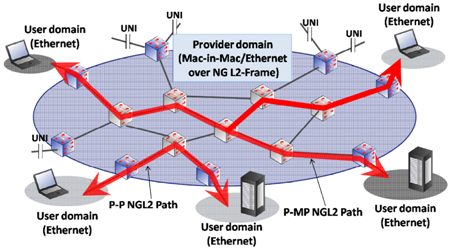
Figure 1: Architecture of our proposed NGL2 network.
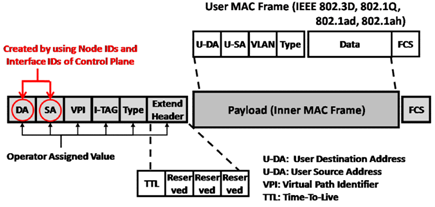
Figure 2: NGL2 MAC frame format.

Biography:
Daisuke Ishii received the B.E., M.E., and Ph.D. degrees from Keio University,Yokohama, Japan, in 2003, 2005, and 2009, respectively. Since 2002, he has been researching an optical network architecture and traffic engineering, particularly in optical burst switching. From 2005 to 2008, he was the Research Assistant with the Keio University COE Program ('05-'07) and Gobal-COE Program ('07-'08) of the Ministry of Education, Culture, Sports, Science, and Technology, Japan.
He is currently an Assistant with the Yamanaka Laboratory, Department of Information and Computer Science, Keio University. He researches a next generation photonic network architecture and an optical network control technique as represented by GMPLS. He is a member of IEICE, OSA and IEEE.
4-2 "Implementation and evaluation of inter-domain Ethernet control between ASON and GMPLS network"
S. Okamoto and T. Otani, KDDI R&D, Japan
 GMPLS network technology has been developed mainly for the time-division multiplex (TDM),
fiber switch capable (FSC). However, considering the rapid growth of Ethernet services these days,
the Ethernet control technology based on layer-2 switch capable (L2SC) becomes quite important. In
addition, inter-carrier L2SC should be also developed for the flexible and efficient control of
wide-area/global Ethernet services. The L2SC for the single domain and between multiple GMPLS
domains has been developed, but the inter-carrier L2SC connection between ASON and GMPLS
domains has not been investigated. From this viewpoint, this presentation describes the
implementation of L2SC control between ASON and GMPLS domains. This presentation also
provides the experimental result of interoperability test of L2SC between ASON and GMPLS
domains.
GMPLS network technology has been developed mainly for the time-division multiplex (TDM),
fiber switch capable (FSC). However, considering the rapid growth of Ethernet services these days,
the Ethernet control technology based on layer-2 switch capable (L2SC) becomes quite important. In
addition, inter-carrier L2SC should be also developed for the flexible and efficient control of
wide-area/global Ethernet services. The L2SC for the single domain and between multiple GMPLS
domains has been developed, but the inter-carrier L2SC connection between ASON and GMPLS
domains has not been investigated. From this viewpoint, this presentation describes the
implementation of L2SC control between ASON and GMPLS domains. This presentation also
provides the experimental result of interoperability test of L2SC between ASON and GMPLS
domains.
As the issues of the inter-domain routing between ASON and GMPLS networks, firstly
this presentation describes the difference of the definition regarding the destination node address
between the ASON and GMPLS networks. Nextly the routing functionalities in order to exchange
and advertise the reachability information of destination node address between the domains are
shown. As for the signaling, this presentation notes the different types of explicit route object format
between ASON network with multi-session signaling and GMPLS network with single-session
signaling. Then the RSVP-TE signaling functionalities on the intermediate AS border router (ASBR)
are described so as to accept these types of route description and calculate the route toward
destination or next ASBR. In addition, the implementation in order to accept the differences of
RSVP-TE object between ASON and GMPLS network is also described. In this L2SC
implementation, the fixed port-label value consisting of the tagged/untagged flag, physical port and
VLAN-ID is utilized. However, considering the effective utilization of VLAN-IDs in inter-domain
Ethernet connection, a VLAN-ID should be selected from available multiple VLAN-IDs assigned to
single TE-link. So this presentation discusses effective utilization of this information.
Finally this presentation is summarized by providing brief overview of L2SC LSP creation
experiment between ASON and GMPLS in the Keihanna Interoperability Project.

Biography:
Shuichi Okamoto received the B.E. and M.E. degrees from Osaka University, Japan, in 2000 and 2003, respectively. He joined KDDI R&D Laboratories, Inc. in 2003. He was a researcher of the National Institute of Information and Communication Technology (NICT) Tsukuba Research Center from 2004 to 2006. Currently he is a reseacher of KDDI R&D Laboratories Inc., and investigating the GMPLS technology from the operational point of view.
4-3 "Prototyping MPLS-TP forwarding and OAM"
Wei Zhao, Ericsson Research, Loa Andersson, Ericsson Packet Networks, and Pontus Sköldström, Acreo AB, Sweden
 Introduction
Introduction
We have developed a prototype in order to investigate how MPLS-TP OAM, or more specifically,
the Generic Associated Channel (G-ACH) and Generic Associated Label (GAL)1, works in a
number of pre-defined scenarios. Using the prototype a detailed investigation into how the timeto-
live field of a shim label influences the forwarding and processing behavior of MPLS-TP OAM
packets will be performed. This work will provide insight into how protection switching can be
achieved on segment, tandem and end-to-end level. This is done as a part of a multi-domain
multi-technology network OAM inter-working project carried by Packet Technologies at Ericsson
Research in collaboration with Acreo AB.
Testbed setup
Testing is being performed in a testbed consisting of a number of virtualized PCs running
GNU/Linux and a homebrewn user-space MPLS implementation. The MPLS software is able to
encapsulate Ethernet frames and forward them in the standard MPLS manner, with the
difference that G-ACH support has been added. By using Ethernet over IP tunnels different
topologies can easily be created and used to run test scenarios that utilize the G-ACH.
Test cases
Four test cases have been identified for prototyping:
- single LSP. This is the basic case to show how MPLS-TP forwarding should be done,
with a focus on G-ACH and GAL processing and the use of TTL field to address an MIP
in the middle of an LSP. See figure 1.
- Nested LSPs. This case will investigate how TTL field should be handled when nested
maintenance association levels are used. See figure 2.
- Nested LSPs with working and backup path over the same number of hops. This
case will investigate how a failure on the working path can be detected using MPLS-TP
OAM and how this can trigger protection switching. See figure 3.
- Nested LSPs with working and backup path over different number of hops. This
case will investigate how the GAL node addressing will be influenced by the hop
difference in a protection switching scenario. See figure 4.
Results and conclusions
The prototype result will provide a primary understanding of how MPLS-TP OAM should be
implemented, identify limitations of the current OAM specifications, provide OAM solutions for
the pre-defined scenarios and propose necessary improvements to the ongoing MPLS-TP
standardization work.
1 As proposed in the current Internet-Draft “MPLS Generic Associated Channel”.

Figure 1: Test case 1, a simple LSP.

Figure 2. Test case 2, LSP nesting.
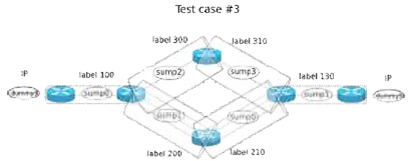
Figure 3. Test case 3, protection switching with equal length paths.
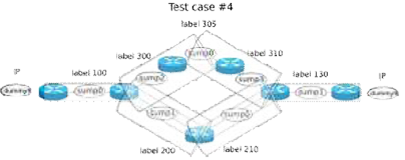
Figure 4. Test case 4, protection switching with unequal length of paths.

Biography:
Wei Zhao started at Ericsson Research as a research engineer in 2000. Her research areas and expertise cover a broad scope of packet network and transport technologies, including IP, MPLS, Ethernet, etc. She has extensive experience in Ethernet OAM, MPLS-TP, fixed-mobile network convergence, mobile core network, QoS, policy based networking, IPv6, and routing. She is involved in European Union research projects and contributes to MPLS-TP standardization work in IETF. Her current research focus is MPLS-TP OAM and OAM inter-working between heterogeneous networks, e.g., MPLS and Ethernet.
Wei works at Ericsson in Sweden and has an M.Sc degree in computer science from Chinese Academy of Science.
4-4 "Development of Packet Transport System using MPLS-TP technologies"
Kenichi Sakamoto, Hitachi, Ltd., Japan
 We propose the next generation packet transport system, which partially uses the MPLS-TP (Multi-Protocol Label Switching-Transport
Profile) technologies. The concepts of the system are (1) High reliability using OAM (Operation Administration and Maintenance) and
protection, (2) Assured packet transfer for each users using static LSP (Label switched Path) control with NMS (Network Management
System). In this presentation, High reliability issues are discussed, and in the other presentation we discuss about assured transfer issues.
We propose the next generation packet transport system, which partially uses the MPLS-TP (Multi-Protocol Label Switching-Transport
Profile) technologies. The concepts of the system are (1) High reliability using OAM (Operation Administration and Maintenance) and
protection, (2) Assured packet transfer for each users using static LSP (Label switched Path) control with NMS (Network Management
System). In this presentation, High reliability issues are discussed, and in the other presentation we discuss about assured transfer issues.
1. Backgrounds
As network application used in business scene, importance of networking for business is expanding. For such networks, by now, two kinds
of network are used. One is leased line, for example, ATM (Asynchronous Transfer Mode) access services, which is very reliable but
relatively slow. The other is packet-based VPN (Virtual Private Network) services, for example, IP-VPN or Metro Ethernet, which is very
fast and best-effort basis.
As the importance of networking increases, the network is required both wide band-width and reliability. The valuable length packet
technologies, for example, Ethernet or IP forwarding progressed nearly, it is advantageous to use these technologies to make high speed
network. On the other hand, it is very crucial to make networks reliable, so that they maintain their connectivity as much as possible. To meet
these requirements, we tried to develop packet-based reliable network.
2. Development of MPLS based packet transport system
For that purpose, we developed the MPLS-TP based packet transport system. To proceed the manageability of the network, we use the static
MPLS LSPs which are managed from NMS (Figure 1). Each LSP is supervised with embedded OAM tools. Moreover when one LSP is set
on the network, NMS checks the capacity of resources on each transport system, then assured transfer is accomplished.
3. Implementation of OAM technologies on the system
It supports the OAM functionality for each LSPs (users), continuity verification, AIS/RDI, and Loopback. As all the technologies are
implemented as hardware, these functions can be performed respectively. For all the LSPs, 1:1 protection with APS (Automatic Protection
Switching) mechanism is implemented.
4. Conclusion
We developed the next generation packet transport system, which can be used to make very reliable network. In the system, we used static
path with MPLS label set by NMS and supervise these paths with embedded OAM tools.
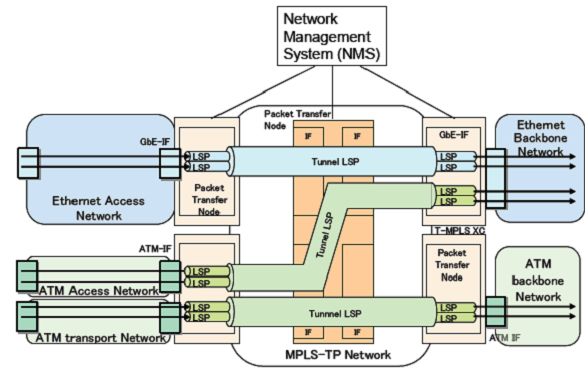
Figure 1. Proposed packet transfer system

Biography:
KENICHI SAKAMOTO received the B.E., M.E. degrees in electrical engineering from Kyoto University, Kyoto Japan, in 1992 and 1994 respectively. He joined the Central Research Laboratory, Hitachi Ltd., Kokubunji Tokyo. He was a visiting researcher of Electrical Engineering Department of Stanford university from 2000 to 2001. His reserach interest is in the area of network architecture, optical access networking and network node architecture. Mr. Sakamoto is a member of IEEE and the Institute of Electronics, Information, and Communication Engineers of Japan.
|
| Technical Session |
|
Tech. Session 5: WSON architecture and Testbed
Friday 12, June 2009 15:05-15:55
Chair: Daniel King, Old Dog Consulting, UK
5-1 "Management and Control Issues in Spectrum-Sliced Elastic Optical Path Network (SLICE)"
Masahiko Jinno, Hidehiko Takara, Bartłomiej Kozicki, Yukio Tsukishima, Yoshiaki Sone, and Shinji Matsuoka, NTT, Japan
 The sustaining growth of data traffic volume calls for an introduction of an efficient
and scalable transport platform for links of 100 Gb/s and beyond in the future
optical network. In this presentation, we first discuss the existing major scalable
optical network technology options and present their strengths as well as
weaknesses. Next, we describe the concept and architecture of a novel,
spectrum-efficient and scalable optical transport network architecture called
spectrum-sliced “elastic optical path” network (SLICE). SLICE brings numerous
enhancements in spectral-efficiency and new degree of spectrum assignment in the
form of:
The sustaining growth of data traffic volume calls for an introduction of an efficient
and scalable transport platform for links of 100 Gb/s and beyond in the future
optical network. In this presentation, we first discuss the existing major scalable
optical network technology options and present their strengths as well as
weaknesses. Next, we describe the concept and architecture of a novel,
spectrum-efficient and scalable optical transport network architecture called
spectrum-sliced “elastic optical path” network (SLICE). SLICE brings numerous
enhancements in spectral-efficiency and new degree of spectrum assignment in the
form of:
- Efficient and scalable accommodation of sub-wavelength, super-wavelength,
and multiple rate data traffic
- Elastic bandwidth variation for efficient utilization of network resources and
enhanced survivability
- Future-proof, efficient accommodation of future data rates and modulation
formats.
Dynamic bandwidth variation of elastic optical paths provides network operators
with new business opportunities offering cost-effective and highly available
connectivity services through time-dependent bandwidth sharing, energy-efficient
network operation, and highly survivable restoration with bandwidth squeezing. As
the enabling technologies of SLICE concept, we discuss an optical orthogonal
frequency-division multiplexing-based flexible-rate transponder and a
bandwidth-variable wavelength cross-connect. Then, we present technical
challenges including management and control issues that arise in this new network
architecture. We believe that SLICE will introduce a new degree of freedom and
open up a more significant role for optics in future transport networks.

Biography:
Masahiko Jinno is a Senior Research Engineer, Supervisor, in NTT Network Innovation Laboratories. He received the B.E. and M.E. degrees in electronics engineering from Kanazawa University, Ishikawa, and the Ph.D. degree in engineering from Osaka University, in 1984, 1986, and 1995, respectively. He joined NTT in 1986. He was a guest scientist at the National Institute of Standards and Technology (NIST), Boulder, Colorado, USA, during 1993 - 1994. He received the Young Engineer Award from the Institute of Electronics, Information and Communication Engineers (IEICE) in 1993, the Best Paper Awards for the in 1997, and 1998, and the 2007 Optoelectronics and Communications Conferences.
5-2 "Ericsson Wavelength Switched Optical Networks (WSON) test bed for Proof of Concept (PoC)"
Daniele Ceccarelli and Diego Caviglia, Ericsson Telecomunicazioni, Italy
 Ericsson has recently realized a test bed in its site in Coventry implementing a GMPLS stack for the control
of WSON networks. Purpose of this installation is the Proof of Concept (PoC) of a control plane controlled
photonic network. Such implementation of WSON networks is based on the interaction between three
different entities: a Network Management Application acting also as a PCE, the NE and an external Linux
PC hosting the Control Plane for each of the NEs. The network elements used in this test bed are
commercial ROADMs (MHL3000) with four ways WSS and the network is made by five NEs.
Ericsson has recently realized a test bed in its site in Coventry implementing a GMPLS stack for the control
of WSON networks. Purpose of this installation is the Proof of Concept (PoC) of a control plane controlled
photonic network. Such implementation of WSON networks is based on the interaction between three
different entities: a Network Management Application acting also as a PCE, the NE and an external Linux
PC hosting the Control Plane for each of the NEs. The network elements used in this test bed are
commercial ROADMs (MHL3000) with four ways WSS and the network is made by five NEs.
The following features have been demonstrated:
- Auto-Provisioning
- Auto-provisioning with path definition (unprotected circuit)
- Auto-provisioning with restoration (restorable circuit)
- Restoration
- All the circuit paths are pre-calculated by a centralized PCE that knows in advance both the
traffic matrix and the network impairments
- Pre-planned restoration
- Single fault restoration
- Double fault restoration
- Optical restoration with card sharing
- Network auto-discovery
- Network topology and configuration upload
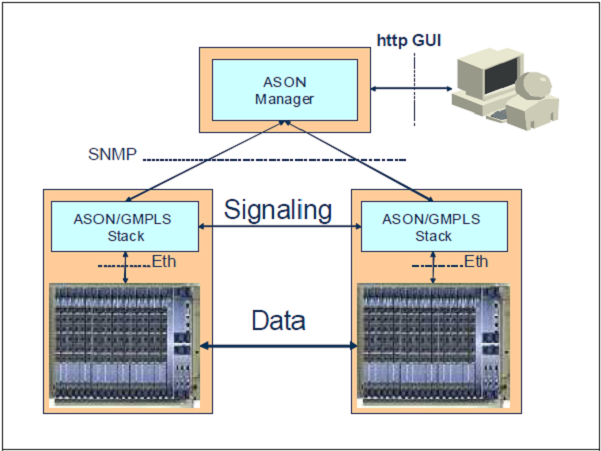
Once that the LSPs are signaled the network is fully controlled by the control plane, that is restoration is
done directly by NEs without any intervention either from human operator or NMS.
The WSON stack includes the entire set of GMPLS protocols: OSPF-TE as routing protocol, RSVP-TE as
signaling protocol and LMP for the management of the links. Due to the fact that the PCE runs offline,
OSPF-TE is not used to feed the PCE database but is used by the different NEs to validate the reserved path
to avoid signaling LSP along no more available paths. All the protocols have been implemented following
IETF related standards.
The presentation will show in details the test bed environment and the major result of this PoC.

Biography:
Diego is working in the standardization arena since beginning of 2000, he's been active in IETF and OIF.
He's co-author of several IETF Internet-Drafts and some RFCs, for the OIF he's been the technical contact point for OIF Interoperability events.
Diego, with respect the standardization activity, is toady working on WSON and MPLS-TP topic.
Diego has been the technical lead for the Marconi/Ericsson GMSPL project today as Ericsson employee Diego has the responsibility as Product Manger for the High Order SDH product family, the planning tools and the Optical Core Solution.
|
| Technical Session |
|
Tech. Session 6: PCE and Traffic engineering
Friday 12, June 2009 16:10-17:50
Chair: Diego Caviglia, Ericsson Telecomunicazioni, Italy
6-1 "Selecting Domain Paths in Inter-Domain MPLS-TE and GMPLS"
Tomonori Takeda, NTT, Japan, Adrian Farrel, and Daniel King, Old Dog Consulting, UK
 The Path Computation Element (PCE) has become a familiar concept and multiple implementations
exist to determine end-to-end paths in multi-domain MPLS-TE and GMPLS networks. PCEs can be
used in per-domain path computation techniques to devolve the computation of a path segment to
each domain entry point. Alternatively, the backward recursive path computation (BRPC)
mechanism allows the PCEs to collaborate to select an optimal end-to-end path that crosses
multiple domains.
The Path Computation Element (PCE) has become a familiar concept and multiple implementations
exist to determine end-to-end paths in multi-domain MPLS-TE and GMPLS networks. PCEs can be
used in per-domain path computation techniques to devolve the computation of a path segment to
each domain entry point. Alternatively, the backward recursive path computation (BRPC)
mechanism allows the PCEs to collaborate to select an optimal end-to-end path that crosses
multiple domains.
These techniques, however, assume that the sequence of domains to be crossed from source to
destination is well known. No explanation is given of how this sequence is generated or what
criteria may be used for the selection between domains. In small clusters of domains, such as
simple cooperation between adjacent ISPs, this selection process is not complex. In more advanced
deployments (such as optical networks constructed from multiple sub-domains, or multi-AS
environments) the choice of domains in the end-to-end domain sequence can be critical to the
determination of an optimum end-to-end path.
In this presentation we explain the latest mechanisms for the selection of domains that comprise the
end-to-end domain sequence. We examine how BRPC could provide the necessary function, but
show how it doesn’t scale to large networks. Instead, a new model of hierarchical PCEs is
explained. This way of performing PCE cooperation enables rapid and scalable selection of optimal
paths and can take advantage of both typical traffic engineering constraints (hop count, bandwidth,
lambda continuity, path cost, etc.) and also more commercially relevant constraints such as policy,
SLAs, security, peering preferences, and dollar costs.

Biography:
Adrian Farrel is an active participant in the IETF and has co-authored many RFCs and Internet-Drafts. He is currently one of two IETF Routing Area Directors where he has the additional responsibility for the MPLS Transport Profile
(MPLS-TP) effort. Adrian was previously co-chaired of the CCAMP, PCE, and L1VPN working groups.
Adrian has been at the forefront of development of solutions for multi-domain traffic engineering for a number of years.
Adrian has authored/edited five books on Internet protocols, and is a frequent presenter at commercial and academic conferences. He runs Old Dog Consulting, specialising in MPLS, GMPLS, and IP routing.
6-2 "An Evaluation of Scalability of PCE-based Routing Model in Multi-Domain GMPLS Networks"
Yohei Iizawa, Itaru Nishioka, Shinya Ishida, Mihoko Nakama, and Soichiro Araki, NEC, Japan
 In the past few years, ASON/GMPLS control plane has been deployed in service
provider’s commercial networks, and their advantage in terms of operational cost
(OPEX) reduction was reported [1]. However, most of such networks are still relatively
small, which are constructed by few tens of nodes, and they have to be expanded to
nation-wide larger networks for more effective OPEX reduction. To control larger
networks, typically thousands of nodes, we have studied qualitatively and concluded
that the PCE-based routing was the most suitable model rather than other routing
models, the per-domain routing and the ASON hierarchical routing [2]. But
quantitative study using a large network test environment has not been reported yet.
In the past few years, ASON/GMPLS control plane has been deployed in service
provider’s commercial networks, and their advantage in terms of operational cost
(OPEX) reduction was reported [1]. However, most of such networks are still relatively
small, which are constructed by few tens of nodes, and they have to be expanded to
nation-wide larger networks for more effective OPEX reduction. To control larger
networks, typically thousands of nodes, we have studied qualitatively and concluded
that the PCE-based routing was the most suitable model rather than other routing
models, the per-domain routing and the ASON hierarchical routing [2]. But
quantitative study using a large network test environment has not been reported yet.
The purpose of the study is to demonstrate, quantitatively, scalable PCE+GMPLS
control architecture, in large size of multi-domain networks. In order to evaluate its
scalability, a PC-based 1000-node test network has been developed in our Lab. This test
network is composed of twelve service domains, and each of which has several OSPF
areas. GMPLS controllers (i.e. OSPF-TE and RSVP-TE) are implemented in the
PC-based nodes, and a PCE is located in each area. To compute inter-domain paths,
PCEs support BRPC for shortest path computation as well as an automatic PCE
selection mechanism based on routing information of control plane networks. Also PCEs
and GMPLS controllers support Path Key, so as to setup end-to-end path with
preserving confidentiality among domains.
In the presentation, we will discuss impacts to PCE+GMPLS control plane when the
number of service domains or areas is increasing, and will also provide measured
performance results for inter-domain path computations and path setups.
Acknowledgement
This work is a part of “Lambda Utility Project” supported by National Institute of
Information and Communications Technology (NICT).
Reference
[1] S. Liu and L. Chen, “Deployment of Carrier-Grade Bandwidth-on-Demand Services
over Optical Transport Networks: A Verizon Experience”, OFC/NFOEC 2007 NThC3,
2007.
[2] I. Nishioka, S. Ishida, Y. Iizawa, “End-to-End path routing with PCEs in
multi-domain GMPLS networks”, iPOP2008 T3-2, 2008.

Biography:
Yohei Iizawa received the B.S. and M.S. degrees in physics from Tohoku University, Sendai, Japan, in 2004 and 2006, respectively.
In 2006, he joined System Platforms Research Laboratories, NEC Corporation, Kawasaki, Japan.
His current research interests are the design of optical network and their control architecture.
6-3 (Cancelled)
6-4 "Supporting Multicast over a Multi-domain Optical Network"
Daniel King, Old Dog Consulting, UK
 Multicast services are increasingly in demand for high-capacity applications such as multicast VPNs, IPTV
(on-demand or streaming), and content-rich media distribution (for example, software distribution, financial
streaming, or data-sharing).
Multicast services are increasingly in demand for high-capacity applications such as multicast VPNs, IPTV
(on-demand or streaming), and content-rich media distribution (for example, software distribution, financial
streaming, or data-sharing).
Operators of packet networks have been quick to recognise the benefits of multicast IP and point-tomultipoint
MPLS-TE as tools to optimise network resource usage, and to transmit only one copy of data on
shared links towards the multiple destinations. Additionally, the use of MPLS-TE helps provide Quality of
Service through resource reservation, traffic engineering, and the management of back-up paths.
However, in a multi-layer network the benefits of IP multicast and P2MP MPLS-TE cannot be fully realised
without also considering resource sharing in the optical transport layer. For example, as shown in Figure 1, a
router may consider itself to be immediately adjacent to two down stream routers in the distribution tree
meaning that it should make copies of the data and transmit them separately. But within the optical network,
the paths between the routers may be substantially shared. The most optimal use of the network can only be
achieved by utilising P2MP in the optical layer.
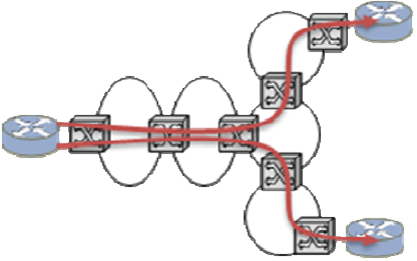
Figure 1: Multi-layer P2MP
This presentation examines how a multi-layer P2MP solution can be built, and looks at the implications for
P2MP in multi-domain networks. We examine how multi-domain issues in the packet layer are more
prevalent in the transport layer, and show how to combine network planning techniques with new Path
Computation Element ideas to achieve optimal delivery of high-capacity multicast services over multidomain
optical networks.

Biography:
Daniel King is an active contributor and author within the IETF's PCE and CCAMP working groups and is an editor or author on a number of IETF Internet-Drafts and RFCs related to path computation and network optimization. Daniel is secretary of two IETF working groups, namely CCAMP and L3VPN. Daniel has wide experience of packet and optical networks, having worked at a variety of vendors, and he was a founder of path computation specialists Aria Networks. He is now a senior consultant with Old Dog Consulting.
|
| Closing Remarks |
Friday 12, June 2009 17:50-18:05
Naoaki Yamanaka, Organization Committee Chair, Keio University, Japan
|
|
